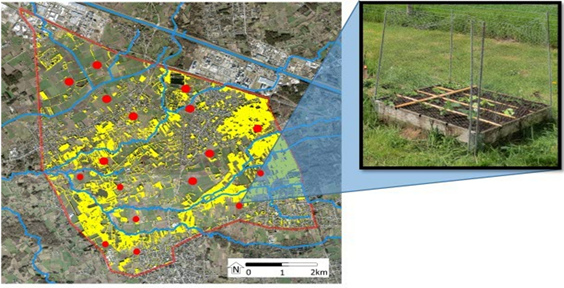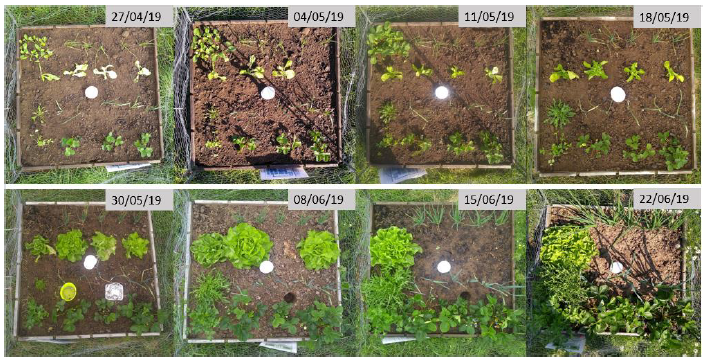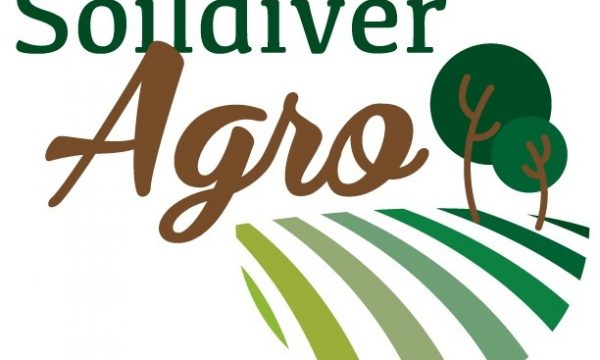Press release Citizen science project with square-meter gardens shows impact of landscape
“The layout of our agricultural space - with fields, private gardens, public space and nature strips has an impact on biodiversity and climate buffering.”
Not only farmers can create more or less biodiversity on farmland. Nearby gardens, roads, nature strips and other landscape elements also have an important impact on the presence of beneficial insects and the microclimate on fields. This is evident from measurements by citizen scientists in some 40 identical 1m² gardens, supervised by researcher Frederik Gerits (ILVO-UGent). In environments with a lot of arable farming, the volunteers counted more natural pests. Herb-rich roadsides and extensively managed grasslands also attract beneficial insects, while buildings impoverish biodiversity. In turn, trees and shrubs in the landscape are effective as buffers against drought and heat in the fields present.
In densely populated areas such as Flanders, nearby cities have great influence on the countryside. In this case, we speak of a "peri-urban countryside" in which private gardens, road systems, nature fragments, grasslands, fields and other forms of land use are strongly intertwined. Moreover, the agricultural landscapes in Flanders are intensively used. There is little diversity of crop species and varieties in the fields, but there are also few wood edges, tree rows, flower borders and herb-rich verges. As a result, biodiversity in the countryside in Flanders is under pressure.
Innovative measurement method: citizen science in identical 1m² gardens in strategically chosen locations
In his PhD, Frederik Gerits (ILVO-UGent) investigated the impact of this landscape interconnectedness and its variations on rural health. He looked specifically at the impact on agrobiodiversity and ecosystem services such as pollination, natural pest control, (quality) food production and regulation of the microclimate. The method he developed for that research is groundbreaking and was emulated in a major European project(Fabulous Farmers).
With the help of an engaged group of citizen scientists, he managed and monitored 41 identical 1m² gardens placed in landscapes that differed greatly in terms of layout, land management and use in an initial research area. These were specifically sites in Lemberge, Gontrode, Landskouter and Gijzenzele. Together, these sites form a representative mirror of the peri-urban countryside in Flanders. As a result, the results from the garden sites can be extrapolated to all of Flanders.


Herb-rich roadsides and grasslands attract pests and pollinators
Interestingly, there was effectively a difference in the insect community observed by the citizen scientists while managing the gardens in the same way. It is the landscape environment that explains the difference in biodiversity. In environments with a lot of arable farming, for example, more natural pest predators were measured than in areas with a lot of gardens and construction. Indeed, the more pavement in the environment, the fewer insects were found. Environments with many (un)herbaceous roadsides and extensive grasslands are also conducive to the presence of insects, especially pest insects that move along the ground.
Trees and shrubs buffer against weather extremes
The design of our landscape also clearly impacts the buffering capacity of the countryside during extreme weather events (ecosystem service microclimate). Gerits investigated this by monitoring temperature and soil moisture levels in gardens via sensors. In landscapes with many woody elements such as tall woody borders, tree rows and small forest fragments, the gardens experienced less variation in temperature and in soil moisture content. In contrast, in environments with more arable and paved surfaces, temperature and soil moisture content in the gardens fluctuated more.
Engagement of all actors important for future challenges
These results highlight the challenge but also opportunities in rural areas. First, it is clear that not one actor - farmers - but multiple actors are responsible for the health of the agricultural environment. This calls into question policies that focus on financial incentives for one actor's efforts on one parcel.
It is more interesting to invest in local partnerships in which farmers and other rural actors work together to create a greener and more biodiverse agricultural landscape.
The citizen science project during Gerit's doctoral research is a great example of the potential impact of local partnerships on awareness as well as behavior. Indeed, a survey of citizen scientists showed that they have become highly aware of their impact on the environment. Several participants even changed their habits after the research, e.g. by cutting the grass less often.
Secondly, the research makes it clear that through targeted interventions in the landscape there are effective gains to be made, for agriculture, people and the environment.We need to make choices together. Where can we incorporate strategic vegetation such as trees/shrubs as climate buffers? Where should we support the presence of beneficial insects with herb-rich roadsides/grasslands? How can we systematically begin to deseal all the concrete in our rural areas?
More info
The results of the BEL Landscape project that is part of Gerit's PhD can be found here: Biodiversiteit en ecosysteemdiensten van en voor landbouw. On 14 March 2023 Frederik Gerits defended his doctoral thesis “Understanding the impact of landscape composition on agrobiodiversity in a peri-urban context: learnings from a citizen-science approach” at the Faculty of Bioengineering Sciences — Ghent University. Gerits work was supported by the Flemish Fund for Scientific Research (FWO).


